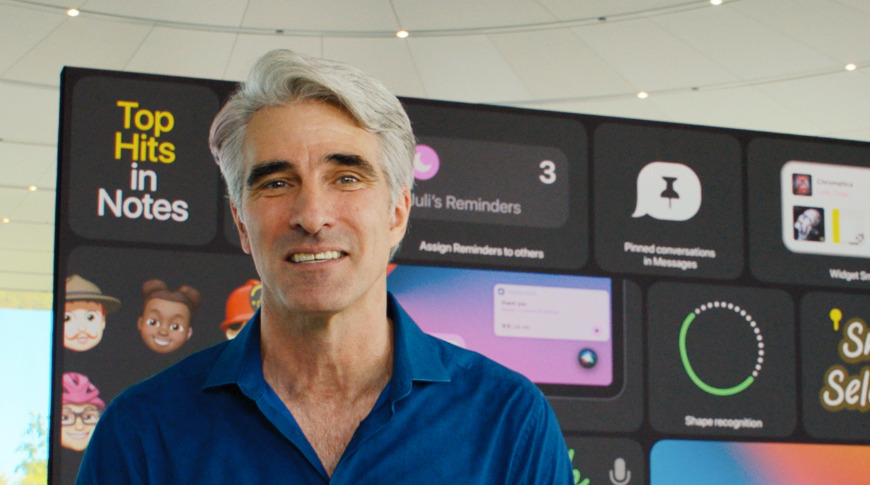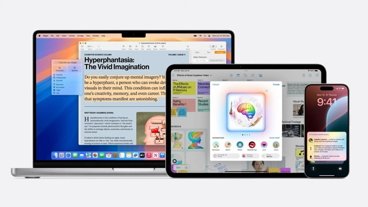Apple SVP of software engineering Craig Federighi has appeared on Marques Brownlee's podcast, answering questions that developers have raised since the WWDC keynote.
After his and Apple marketing vice president Greg Joswiak talked on video, Craig Federighi has now also appeared on Marques Brownlee's Waveform podcast. He was questioned about Apple's thinking over the technologies announced at WWDC, and also pressed on criticisms that developers have had since then.
Siri's new interface
One of those concerned the new visual form of Siri, which no longer covers the entire screen — but which does prevent you from interacting with what else is on that display at the time. Federighi says that's intentional.
"We tried it both ways," he said. "Internally, we had prototypes running, where you would scroll behind the Siri answers as you brought them up. And initially we thought that was going to be really great, so we implemented it that way and then what we found was that for most of the interactions we were having with Siri, that then created this kind of extra heaviness to it."
"Because if you just say, wanted to check the weather, or look up a piece of information, and then you were ready to move on, your scroll gesture wasn't gonna move on," he continued. "The Siri result was going to stick around there so you always have this additional step of dismissing the result."
"We'll continue to listen to what people say through beta period because, like I say, we've actually had it working both ways," he said. "But our feeling was that we wanted to achieve a great lightness, not just visually but in terms of you could dip into Siri get an answer and move on quickly without any kind of overhead."
Default apps
Federighi also addressed the question of why Apple was now allowing the default Mail and browser apps to be changed by the user, but nothing else, no other apps. He said that the choice for now was deliberate, but that didn't mean it won't change.
"We know how platforms can sort of descend into chaos," he said, "and particularly when apps that you know might honestly not even be browsers... decide they're going to be a browser. And then [they] try to redirect you to a different tract ad experience when you click on something... or who knows what."
"And so we are very careful about making sure that that experience that we don't have people misled," he continued, "or have their device gets configured into a place where boy they just don't even like like using their phone anymore because it's gotten so locked up. So we proceed cautiously on these things for sure."
Apple Silicon and apps
Apple has been criticized before for saying that developers can just use a tickbox and have their apps convert to a new platform or some new system. So Brownlee pressed Federighi on just how true it can be that developers will find converting to Apple Silicon easy.
"We feel really great about how the transition is already starting and how it will go," started Federighi. "Most applications out there have really modernized over the years to use our latest developer tools, to be 64 bit clean, [and] to use our modern set of frameworks and it turns out that that means moving to Apple Silicon in some cases is literally recompiling."
"We've seen many examples of that," he continued. "More sophisticated apps like Microsoft Office and Adobe Suite, some of these apps have decades of engineering, you know, hundreds and hundreds of people working for decades creating code and sometimes having dependencies on different libraries and so forth and those are bigger projects."
"But I think the amazing thing that I hope everyone can take away from the presentation was that those apps, [Office and Adobe], have been completely brought over," he said.
"And it wasn't like [Microsoft or Adobe] had to mobilize the entire engineering team," he continued. "This was incredibly secret, and so we said, could you give us a person or two and let's get those apps up and running. "
"We [did] it in a relatively short period of time and those are some of the hardest apps you could imagine bringing over," he said.
The full 90-minute podcast can be heard here, and includes much more about Federighi's take on WWDC, and especially the exceptional video keynote.
Keep up with all the Apple news with your iPhone, iPad, or Mac. Say, "Hey, Siri, play AppleInsider Daily," — or bookmark this link — and you'll get a fast update direct from the AppleInsider team.
 William Gallagher
William Gallagher


-m.jpg)






 Andrew O'Hara
Andrew O'Hara
 Wesley Hilliard
Wesley Hilliard

 Malcolm Owen
Malcolm Owen
 Marko Zivkovic
Marko Zivkovic

 Chip Loder
Chip Loder
 Christine McKee
Christine McKee

-xl-m.jpg)


-m.jpg)




10 Comments
Based from all that have seen since Monday I think this is what went down a couple years back in Apple Senior officer meeting.
ans: “we can use our own chip!” Saids Johnny Srouji
” yeah. But is our chip good enough to replace Intel? This decision can not be a decision based on anger. If we are gonna move, we have to know that what ever we have has to be better. Otherwise what’s the point? “
”but if we move to ARM, how about x86 GPU? Our customers are gonna be expecting the performance that AMD will bring. Can we even do that?”
ans: yes. Our prototype chip is a scaled A13 chip. We know what Nvidia and AMD are doing with their upcoming offerings. What we can do is increase our compute units but keep it at low power consumption. The result is a low heat but powerful chip that matches a Dedicated GpU solution. Our team uses the dedicated GpU from AMd and Nvidia as benchmark for development criteria’s. To convince our customers to move to ARM with us is a major move. So the bare minimum of performance must be set higher than what will be available when and if the chip launches.
ans: [everyone] yes. Let’s do it.
this is speculative. But it’s the sort of discussion that we do at my company. We often have supplier reviews. Check their quality and delivery performance. We discuss long term strategic plans like this as well. Weight out the pros and cons. Then make the decision and announce. We are not a big company like Apple, but I expect their senior discussion meeting to be quite similar. Their decisions have many ramifications. To their users, suppliers and developers. Their decision to move must have enough reasoning to justify the risks taken. Remember, the said chip, is guarded behind the mothership’s walls. Basing anything on just the Dev Kit A12z as benchmark isn’t a good idea. Strategically speaking, they know they need to release an ARM chip to the public so they can write their code on. The A12z is already good and is publicly known. “We’ll use that for developers so they have a test platform. We can’t release the new chip just yet. It’s gotta be kept secret for the time being”. I think Apple knows regardless of their “no benchmark” policy of the dev machines, someone will still do it. Words gonna get out how well or bad the chip is gonna do on MacOS Big Sur. So giving devs / public a glimpse of “hey! A12z is a great chip right? It can do anything you ask of it.”
I think Apple has a very good chance of taking the crown from x86 both in single thread and multi-thread. Three reasons:
1. Apple is TSMC’s number on customer. They are a year ahead of AMD in accessing the latest fab process
2. Apple has far more resources that AMD for design
3. apples control of the entire software stack gives them an advantage in optimization